Electric Power not Fossil Fuel
Saudi Arabia’s Public Investment Fund in collaboration with E1 organized world racing championship for electric powered boats as part of its climate change initiative and reducing reliance on fossil fuels thereby decreasing hazardous environmental impact in order to protect the Kingdom of Saudi Arabia’s marine ecosystem . The electric powerboat series E1 got an opportunity to showcase its new electric RaceBird powerboat for the championships capable of achieving a maximum speed of 110 kph and battery time of 20 minutes.
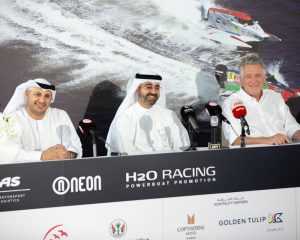 Credit UAE News
Credit UAE News
As racing championships take place offshore the category of boats determine the mode of championship taking place. Class One Powerboats are considered to be top of the line at par with that of Formula Auto Racing cars. Powerboats generate 3000 horsepower and their lengths range between 30-50 feet clocking speeds upto 160 mph .
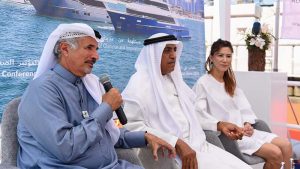 Credit Expat Media
Credit Expat Media
Wind Power
Secretary General of the World Professional Powerboating Association Sid Bensalah shared that a regatta is being held in the United Arab Emirates at a cost of around $ 2.7 million .Traditional dhow racing events utilise wind power.The Al-Gaffal Traditional Dhow Race takes place annually to celebrate the traditional dhow on Sir Bu Nair Island about 100 kilometers west of Dubai.The race continues for almost 5 hours and the finish line is the iconic Burj Al-Arab hotel which depicts a sail. In the year 2022 Sheikh Sultan Bin Mohammed Bin Sultan Al Qasimi, Crown Prince patronized the the Sharjah World Championship Week at Khalid Lagoon.
Tourism Revival after Pandemic
The revival of Class 3 powerboat racing in the Emirates of Abu Dhabi kicked off with the advent of American throttleman Shaun Torrente and Emirati driver Faleh Al Mansoori who have been a winning combination of Team Abu Dhabi’s former Union Internationale Motonautique XCAT World Championship .To promote marine tourism the Abu Dhabi Marine Sports Club has taken the lead and its marketing strategy is to hold the races in the pleasant winter season which coincide with the hordes of tourists flocking from Europe ,USA, Israel, India and Pakistan .The club since 13 years has been hosting the famous President’s Cup for Formula 2000 and the older version of Championships such as UIM Class 1 World Powerboat Championship .The UAE tourism authorities are smartly utilizing sea ports to attract maritime sports enthusiasts who would go to other water resorts and islands.
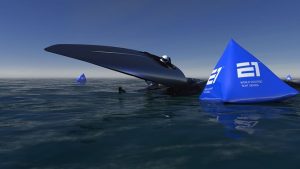 Credit Arab News
Credit Arab News
The Saudis and Emiratis adhere to safety standards .Fatal crashes have occured and it is imperative that the powerboats are equipped with airbags, automatic fire extinguishers , emergency kill switches , crew is a minimum of two and it is compulsory to wear helmets
India Leaps into Powerboat Racing
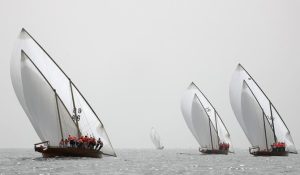 Credit Arab News
Credit Arab News
India hosted the F1H20 World Championship on a 23 km stretch of the River Krishna in 2018 . Toxic discharge from cement projects ,biotech and chemical factories upstream Krishna river are polluting the water and the stench dissuaded enthusiasts from returning hence the venue for next F1H20 World Championship was in China . Teams from Portugal, Italy, United Arab Emirates, France and local Team Amaravati participated in the event and to manage it the Chief Minister ordered the closure of the Prakasam Barrage for 2 days. The intent was to place India on the global water sports map which, much to the chagrin of the Indian tourism authorities, did not happen.
Saudi Defense Paranoia
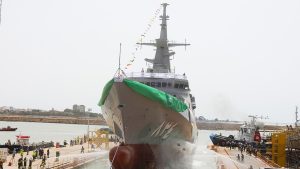 Credit BREAKING DEFENSE
Credit BREAKING DEFENSE
While patronising water sports the Saudi government is conscious that it has to protect its waters from pirates and marauders and ensure navigational safety for its crude carriers off the Gulf of Aden . The Navy has concurrently launched an ambitious, multi billion dollar fleet modernization initiative comprising of an indigenously developed combat management system known as Hazem. In a joint venture between Saudi Military and Spanish shipbuilder Navantia a quintet of Avante 2200 corvettes ,equipped with sophisticated air defense and anti-submarine warfare systems ,have arrived at Saudi Naval bases and are being deployed along its Western coast stretching 1800 km along the Red Sea. Strategically the corvettes can host attack helicopters.
The contributor Razeen Ahmed , is a Honours graduate from London School of Economics and pursues research in Maritime Logistics and Finance

Leave A Comment